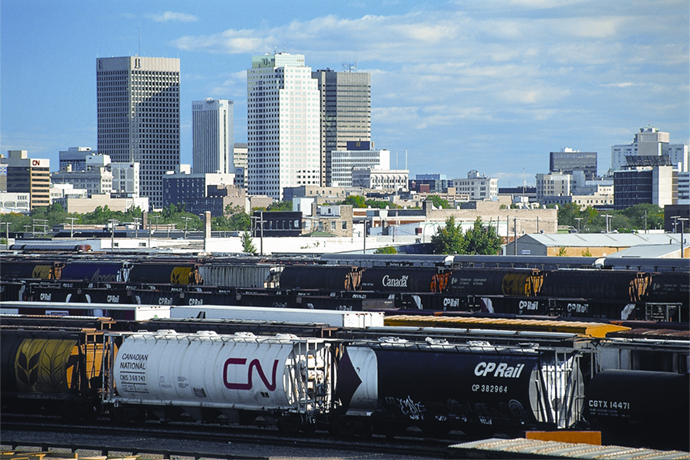Winnipeg, Manitoba, is the overall lowest-cost city of 26 Midwestern US and Western Canada metros included in the 2014 edition of KPMG’s Competitive Alternatives Guide to International Location Costs. The study analyzes more than 100 cities in 10 countries: Canada, the US, Mexico, the Netherlands, France, the UK, Japan, Australia, Germany and Italy. For each metro, Competitive Alternatives compares costs associated with seven business-to-business service sectors and 12 manufacturing sector operations. Of the 26 metros, Winnipeg ranks first – most favorable in terms of costs – in digital services, research and development and manufacturing, and second in corporate services. The study also addresses such non-cost factors as labor availability, innovation, quality of life, cost of living and infrastructure.
“Our economy has fared extremely well coming through the recession,” Manitoba Premier Greg Selinger told Site Selection in an interview on May 7th. “We were second or third in economic growth across Canada for the past five years. Our objective is to keep it moving in the right direction.” How?
“We have reinvented our manufacturing sector with very strong investments in technology and in improving productivity on the technology side but also skilling up our labor force. We have made our regime of taxation in Manitoba extremely competitive. And we have an extremely strong competitive advantage over anywhere in North America when it comes to electricity or energy. Hydroelectric costs are the lowest in North America and the cleanest.”
Selinger says Manitoba is investing in its hydroelectric power infrastructure “in full partnership with First Nations, dealing with all the environmental issues as we build out new capacity.”
A Transportation Hub for North America
Logistics infrastructure is no less important, notes the Premier. This spring saw the launch of a major infrastructure program, focusing on places like CentrePort Canada – Manitoba’s 20,000-acre inland port and the first logistics hub in Canada to offer investors single-window access to FTZ benefits. CentrePort is the only inland port in Canada with direct access to tri-modal transportation – truck, rail and air cargo.
In mid-May, Houston-based Goodman Manufacturing Group, a producer of air conditioning and heating systems, opened its first Winnipeg branch – nearly 12,000 square-feet of warehouse, showroom and office space in a newly constructed, multi-tenant building at Brookside Business Park, one of CentrePort’s main industrial parks.
“We had some customers in Winnipeg that we were serving from other branches, but we saw an opportunity to grow our business here,” said Branch Manager Mike MacCorby. “We selected this location at CentrePort after several years of looking at Winnipeg real estate. It offered us the quality of facility that we were not able to find elsewhere within the city.”
Goodman is the first tenant of a new, 44,000-square-foot multi-tenant building that was recently completed by Calgary-based Olexa Developments, the developer of the 150-acre industrial park. The facility is CentrePort’s first-ever speculative building, an important milestone in efforts to increase the industrial capacity at Manitoba’s inland port.
“We are a hub for North American transportation,” says the Premier, referring to CentrePort Canada, “We can provide transportation services – rail, road or runway anywhere in North America with a brand new, 24/7 airport and major North American trucking companies.”
Partner in Progress
Products must first be designed and produced before they can move through CentrePort to their end markets, and Manitoba competes aggressively on the front end of that process, as well. This requires an environment where innovation can flourish, and Selinger says Manitoba is the place for that.
“We have the best R&D tax credit in Canada – 20 percent with refundability,” he points out. “And we have very good tax credits for angel investors, who can get back up to 45 percent back now, which is the best in Canada as of this spring’s budget.”
In April, the provincial government put forth the Manitoba Innovation Strategy, a blueprint for realigning resources to better support the entrepreneurial and business communities. Part of that effort is establishing Research Manitoba, which will be a research-funding, advisory and administrative body to oversee provincial research programs.
“The Innovation Strategy has focused on taking an idea and allowing it to go to commercialization with support every step of the way,” says Selinger, “with the educational support around that and the investment around that in terms of investors and tax credits.”
In practical terms, says Selinger, the province worked extensively with Canadian Tire – an iconic national company – in establishing its new Cloud Nine Digital Innovation Centre in Winnipeg.
“They put their server farm in Winnipeg and are pioneering their ‘e-tailing’ technologies in Winnipeg with a major laboratory right downtown,” he explains. “This facility is hiring a lot of our young, skilled application developers. We have partnered with them on the energy side with hydro, the human resource side with our post-secondary institutions and the investment side in terms of the credits we have made available for them to be there.”
